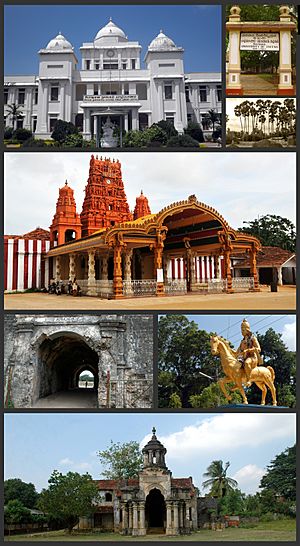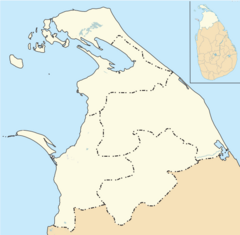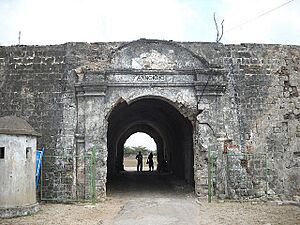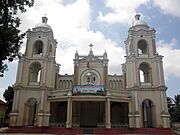Jaffna facts for kids
Quick facts for kids
Jaffna
யாழ்ப்பாணம்
යාපනය |
|
|---|---|
|
City
|
|

Clockwise from top: Jaffna Public Library, the Jaffna-Pannai-Kayts highway, Nallur Kandaswamy temple, Jaffna Fort, Sangiliyan Statue, Jaffna Palace ruins
|
|
| Country | Sri Lanka |
| Province | Northern Province |
| District | Jaffna |
| Government | |
| • Type | Municipal Council |
| Area | |
| • Total | 20.2 km2 (7.8 sq mi) |
| Elevation | 5 m (16 ft) |
| Population
(2012)
|
|
| • Total | 88,138 |
| • Density | 4,363/km2 (11,301/sq mi) |
| Time zone | UTC+5:30 (Sri Lanka Standard Time Zone) |
Jaffna (Tamil: யாழ்ப்பாணம், romanized: Yāḻppāṇam; Sinhala: යාපනය, romanized: Yāpanaya) is a major city in Sri Lanka. It is the capital of the Northern Province. The city is located on a peninsula that shares its name.
In 2012, Jaffna had a population of 88,138 people. This makes it Sri Lanka's 12th most populous city. Jaffna is about 6 miles (10 km) from Kandarodai, an ancient trading center. The nearby area of Nallur was once the capital of the Jaffna Kingdom. This kingdom lasted for four centuries in medieval times.
Before the Sri Lankan Civil War, Jaffna was the second largest city in Sri Lanka. It was smaller only than Colombo. The war, which started in the 1980s, caused a lot of damage. Many people had to leave their homes. Since the war ended in 2009, people have been returning. The government and private companies are helping to rebuild the city.
Jaffna has a long history of being a contested city. The Portuguese took control in 1619. They made it a port town. Later, the Dutch took it from the Portuguese. Then, the British took it from the Dutch in 1796. During the civil war, the Liberation Tigers of Tamil Eelam (LTTE) controlled Jaffna from 1986 to 1987. The Indian Peace Keeping Force (IPKF) briefly took over in 1987. The LTTE controlled it again from 1989 until 1995. Then, the Sri Lankan Army regained control.
Most people in Jaffna are Sri Lankan Tamils. Before the war, there were also many Sri Lankan Moors and Indian Tamils. Most Sri Lankan Tamils are Hindus. There are also Christians, Muslims, and a small number of Buddhists. Jaffna is home to many schools and colleges. It also has banks, hotels, and historical sites. The famous Jaffna Public Library was once burned down but has been rebuilt. The Jaffna Fort was rebuilt during the Dutch period.
Contents
What's in a Name?
Jaffna is known as Yalpanam in Tamil. It was also called Yalpanapattinam a long time ago. An old writing from the 15th century mentions it as Yalpaanayanpaddinam. The word -pattinam means it was a seaport town.
There's a story about how Jaffna got its name. A king was visited by a blind musician. This musician was very good at playing an instrument called the Yal. The king loved the music so much that he gave the musician a sandy area of land. The musician brought other people from his tribe to this new land. It's believed they settled in areas now called Passaiyoor and Gurunagar. Old harbors in these areas seem to support this story.
The everyday name for Yalpanam is Yappanam. The sounds "Ya" and "Ja" can easily be swapped. "Jaffna" is how non-Tamil speakers started saying "Yalpanam." When it became a foreign word, the Tamil ending "m" was dropped. So, it became "Jaffna."
A Look Back in Time
Ancient Settlements
Old digs show that people lived in this area a very long time ago. An ancient seal found here has writings from the Iron Age. This suggests that different family groups lived in the Jaffna Peninsula. Old burial sites with potsherds (broken pottery pieces) also show how people buried their dead long ago.
Pottery found in Jaffna shows trade with South India from 200 BCE to 500 CE. Later finds, like Chinese porcelain, show trade with the Arabian Peninsula and the Far East. This means Jaffna was a busy trading spot for many centuries.
Jaffna and the surrounding area were part of a region called Nāka Nadu. Ancient writings from the 5th century CE mention this area. It was home to the Naga people, who were one of the first tribes in Sri Lanka. By the 9th century CE, they had become part of the Tamil language and culture.
Medieval Kingdom
During the Middle Ages, the Kingdom of Aryacakravarti started in the 13th century. It was first an ally of the Pandyan Empire in South India. When the Pandyan Empire became weaker, the rulers of Jaffna made their kingdom independent. It became a strong power in Sri Lanka. Nallur, a part of modern Jaffna, was the capital of this kingdom.
The Jaffna kingdom grew powerful in the 13th and 14th centuries. Other kingdoms in the region paid tribute to it. But it also faced challenges from the Vijayanagar empire in India and the Kotte Kingdom in southern Sri Lanka. Because of this, Jaffna became a vassal (a kingdom that owes loyalty) to the Vijayanagar Empire. It also lost its independence to the Kotte kingdom for a short time (1450-1467).
The kingdom became independent again when the Kotte kingdom broke apart. It had strong trade and political ties with kingdoms in South India and other parts of Sri Lanka. During this time, many Hindu temples were built. Literature in Tamil and Sanskrit also thrived.
Colonial Rule
The Portuguese built Jaffna city in 1621. It became their center for ruling the area. Before the Portuguese took over in 1619, the capital of the local Jaffna Kingdom was Nallur. This was very close to where Jaffna city is now.
Portuguese traders and missionaries came to Jaffna in the 1590s. They decided to build a strong settlement after capturing the last native king in 1619. The Portuguese moved the main control center from Nallur to Jaffnapatao. This was their name for the old royal capital. Jaffnapatao was a small town with a fort, a harbor, churches, and government buildings. The Portuguese took over the profitable trade of elephants. They also controlled imports from Colombo and India. This made it hard for local merchants. During the Portuguese time, many people moved south. There were also changes in religion. European education and healthcare were introduced to the city.
In 1658, the Portuguese lost Jaffnapatao to the Dutch East India Company. This happened after a three-month siege. During Dutch rule, the city grew bigger and had more people. The Dutch were more accepting of local trade and religions than the Portuguese. Many Hindu temples that the Portuguese had destroyed were rebuilt. A community of mixed European and local people, called Dutch Burghers, grew up. The Dutch rebuilt and greatly expanded the fort. They also built churches and government buildings. Many of these buildings lasted until the 1980s. Jaffna also became an important trading town for local farm products.
Great Britain took over the Dutch areas in Sri Lanka in 1796. The British kept many of the Dutch rules about trade, religion, and taxes. During British rule, many schools were built. These schools helped Jaffna residents become very literate. The British built major roads and a railway line. This connected Jaffna with Colombo, Kandy, and the rest of the country. The city's people became prosperous. They used their wealth to build temples, schools, a library, and a museum.
Modern History
After Sri Lanka became independent from Britain in 1948, relations between the majority Sinhalese and minority Tamils became difficult. Jaffna was seen as the center of Tamil culture and literature in Sri Lanka. Tamil people in Jaffna and elsewhere in Sri Lanka wanted more self-rule. They protested against discrimination.
The Jaffna Public Library was burned down in 1981. This was a very sad event for the city. The disagreements between groups eventually led to a full-scale civil war in 1983. During the war, the Jaffna Fort was used by the Sri Lankan military. It was surrounded by various Tamil groups. The city was bombed from the air and land. This damaged buildings and hurt civilians. In 1986, the Sri Lankan military left the city. The LTTE took full control.
In 1987, Indian forces came to Sri Lanka. They tried to take the city from the rebels. This led to difficult events, including harm to patients and medical workers at the Jaffna hospital. After the Indian forces left, the LTTE controlled the city again. But they were pushed out in 1995 after a long fight.
During the time the LTTE controlled the area, many Muslim residents were forced to leave in 1990. In 1995, all residents were forced to evacuate. The city also faced a lack of power, medicines, and food due to restrictions on goods entering rebel-controlled areas.
Since the civil war ended in 2009, many people who left have started to return. The city is being rebuilt. People from other countries and Sri Lankan businesses are investing in Jaffna.
Where is Jaffna?
Jaffna is surrounded by the Jaffna Lagoon to its west and south. To the north are Kokkuvil and Thirunelveli. Nallur is to the east. The Jaffna Peninsula is mostly made of limestone. This is because it was under the sea a long time ago. The land is mostly flat and just a little above sea level.
Close to the city center is the island of Mandativu. A road connects it to the mainland. You can see many Palmyrah trees in areas not used for buildings. Other plants include a leafless shrub called talai and koddanai (oleander).
Jaffna's Weather
Jaffna has a tropical savanna climate. This means it has a dry season from February to August. The wet season is from September to January. Jaffna has the highest average temperature in Sri Lanka, about 83°F (28°C). The hottest months are April-May and August-September. The coolest months are December-January. The yearly rainfall comes from the North East monsoon. The average rainfall in the western part of Jaffna peninsula is about 1300 mm (51 inches).
| Climate data for Jaffna (1991–2020) | |||||||||||||
|---|---|---|---|---|---|---|---|---|---|---|---|---|---|
| Month | Jan | Feb | Mar | Apr | May | Jun | Jul | Aug | Sep | Oct | Nov | Dec | Year |
| Record high °C (°F) | 35.0 (95.0) |
35.6 (96.1) |
37.8 (100.0) |
38.7 (101.7) |
37.8 (100.0) |
36.7 (98.1) |
37.2 (99.0) |
36.3 (97.3) |
36.8 (98.2) |
35.0 (95.0) |
35.8 (96.4) |
32.2 (90.0) |
38.7 (101.7) |
| Mean daily maximum °C (°F) | 29.3 (84.7) |
30.7 (87.3) |
32.8 (91.0) |
33.8 (92.8) |
32.9 (91.2) |
32.5 (90.5) |
32.6 (90.7) |
32.2 (90.0) |
31.8 (89.2) |
31.2 (88.2) |
29.8 (85.6) |
28.9 (84.0) |
31.5 (88.7) |
| Daily mean °C (°F) | 25.5 (77.9) |
26.2 (79.2) |
27.9 (82.2) |
30.0 (86.0) |
30.3 (86.5) |
30.1 (86.2) |
29.9 (85.8) |
29.5 (85.1) |
29.4 (84.9) |
28.2 (82.8) |
26.7 (80.1) |
25.9 (78.6) |
28.3 (82.9) |
| Mean daily minimum °C (°F) | 21.7 (71.1) |
21.7 (71.1) |
23.4 (74.1) |
26.2 (79.2) |
27.8 (82.0) |
27.7 (81.9) |
27.2 (81.0) |
26.7 (80.1) |
26.5 (79.7) |
25.3 (77.5) |
23.7 (74.7) |
23.0 (73.4) |
25.1 (77.2) |
| Record low °C (°F) | 16.3 (61.3) |
16.2 (61.2) |
16.6 (61.9) |
21.0 (69.8) |
21.2 (70.2) |
21.1 (70.0) |
22.4 (72.3) |
20.4 (68.7) |
21.5 (70.7) |
20.0 (68.0) |
18.0 (64.4) |
16.8 (62.2) |
16.2 (61.2) |
| Average precipitation mm (inches) | 44.3 (1.74) |
25.9 (1.02) |
42.5 (1.67) |
64.7 (2.55) |
66.2 (2.61) |
18.5 (0.73) |
22.6 (0.89) |
57.3 (2.26) |
81.0 (3.19) |
235.0 (9.25) |
437.3 (17.22) |
273.9 (10.78) |
1,369.2 (53.91) |
| Average precipitation days (≥ 1.0 mm) | 3.9 | 2.3 | 3.9 | 5.6 | 3.7 | 1.6 | 2.5 | 4.2 | 4.7 | 12.4 | 17.1 | 11.9 | 73.8 |
| Source 1: NOAA | |||||||||||||
| Source 2: Department of Meteorology (records up to 2007) | |||||||||||||
How Jaffna is Governed
The Jaffna Municipal Council is in charge of governing Jaffna. It was created under a law from 1865. Jaffna did not have an elected council for many years. This was because British officials preferred to rule the city directly. The first elected mayor of Jaffna was Sam A. Sabapathy.
During the civil conflict, some mayors faced difficult situations. For 15 years after 1983, there were no elections. After the civil war ended, elections were held again in 2009. The municipal council has 29 members. The original council building was destroyed during the war. A new building was planned for 2011.
See also: List of mayors of Jaffna
Who Lives in Jaffna?
Historically, people from Jaffna were Tamils, Moors (Muslims), and Europeans. Over time, the mix changed. Tamils and Moors became the main groups. Europeans either blended in or moved away. Europeans and locals used to live in different parts of the city. Houses were usually small, and streets were clean. After the 1900s, the population grew. Sinhalese people from the south also settled in Jaffna. Before the civil war, there were Moors, Sinhalese, Indian Tamils, and other groups living in Jaffna.
During colonial times, Jaffna was the second largest city in Sri Lanka. After Sri Lanka became independent, other cities near Colombo grew faster. But even in 1981, Jaffna was the largest city outside the Greater Colombo area.
The civil war greatly affected Jaffna's population. Many Tamil residents moved to Western countries or to safer areas like Colombo. The city's small Moor and Sinhalese populations were forced to leave or fled. Because of this, the city's population is much lower than it was 30 years ago. Many people who left during the war have settled elsewhere. Since the war ended in 2009, some residents have returned. There are efforts to help more people come back to Jaffna.
| Year | 1880 | 1891 | 1901 | 1911 | 1921 | 1931 | 1946 | 1953 | 1963 | 1971 | 1981 | 1994 | 2007 | 2010 |
|---|---|---|---|---|---|---|---|---|---|---|---|---|---|---|
| Population | 4,000 | 43,179 | 33,879 | 40,441 | 42,436 | 45,708 | 62,543 | 77,811 | 94,670 | 107,184 | 118,224 | 149,000 | 83,563 | 84,416 |
| Rank | 2nd | 3rd | 2nd | 2nd | 2nd | 2nd | 3rd | 3rd | 3rd | 4th | 14th | |||
| Source | Est. | Census | Census | Census | Census | Census | Census | Census | Census | Census | Census | Cen./Est. | Est. | Census |
Areas Around Jaffna
|
|
Religions in Jaffna
Most Tamils in Jaffna are Hindus, following the Shaivite tradition. They also worship local village gods. Most Christians are Roman Catholics. There are also some Protestants, like those from the Church of South India. The Catholic Church has a special area called a diocese in the city. All Moors are Muslims, mostly from the Sunni group. There are also a few Shias who came from North India or Pakistan for trade. A small group of Tamil Buddhists converted to Theravada Buddhism in the 20th century. Most Sinhalese people were either Buddhists or Catholics.
There used to be a small group of nomadic people called Kuravar. They visited Jaffna seasonally and spoke a dialect of Telugu or Tamil. Tamil people also had a caste system. But in urban areas like Jaffna, social class was often more important than caste.
Economy and Travel
Jaffna started as a trading town. It had a port that was used by the local kingdom even before the Portuguese arrived. But European trade made it more important. In colonial times, making clothes, gold and silver items, and processing tobacco and rice were important jobs.
In modern times, the port was the main source of income. But it has become much less active. Now, it mainly serves as a fishing port. The city used to have many industries, like food processing and making household items. Most of these stopped after 1995. Many business owners moved to other parts of Sri Lanka or abroad.
Since 2009, after the civil war, foreign countries and investors have shown interest in Jaffna. New shopping malls like Cargills Square and hotels like Jetwing Jaffna have been built. This is helping the tourism industry grow.
Jaffna is 396 km (246 miles) from Colombo. You can travel there by train and road. The Yal Devi train and other trains used to run daily from Colombo. The main train station in the city is the Jaffna Railway Station. The A-9 highway connects Jaffna to the rest of the country. It was opened after a ceasefire in 2002. Buses also serve the city. Commercial flights are available from Chennai, India and Colombo to Jaffna via the Jaffna International Airport. Since 2017, a ferry service connects Jaffna with Delft islands.
Learning in Jaffna
Jaffna city has many schools and colleges. These were started by missionaries and local reformers during the British colonial period. For example, Peter Percival, a missionary, started schools like Jaffna Central College and Vembadi Girls’ High School. Before the civil war, Jaffna had one of the highest rates of people who could read and write in Sri Lanka.
Books and News
Jaffna has had a media industry since the mid-1800s. The first Tamil and English weekly newspaper was Uthayatharakai (Morning Star). It was published in 1840. Other early newspapers included the Ceylon Patriot and religious journals. The first Tamil monthly magazine was Sanmarkapothini in 1884.
Later, popular Tamil newspapers like Eelakesari and Eelanadu were published. Jaffna also had magazines that focused on modern literature, like Bharati and Marumalarchi. The English weekly Saturday Review was also an important news magazine from Jaffna.
During the civil war, many publishers, writers, and journalists faced difficulties. The media was also heavily controlled. Since the 2000s, Jaffna has newspapers like Uthayan, Yarl Thinakkural, and Valampurii.
Famous Buildings
Some old buildings in Jaffna were destroyed by the Portuguese. These included temples, libraries, and palaces in the royal city of Nallur. Materials from these destroyed buildings were used to build the Jaffna Fort and other defenses. Cankilian Thopu, the entrance to the palace of Cankili I, and Mantri Manai, the minister's palace, are some pre-colonial buildings still standing in Nallur.
Within Jaffna city, the Dutch fort is a very impressive structure. There are also many Dutch-era homes, churches, and government buildings. Most of these were damaged during the civil war. Some notable British colonial buildings include the Indo-Sarasenic style clock tower and the Public Library. Almost all Hindu temples in Jaffna, including the important Nallur Kandaswamy temple, were rebuilt during the Dutch and British periods.
Notable Individuals
See Category:People from Jaffna
Sister Cities
Sister City programs help people from different cities learn about each other's cultures. These programs encourage cultural, educational, business, and technical exchanges.
Jaffna's sister cities are:
See also
 In Spanish: Jaffna para niños
In Spanish: Jaffna para niños






